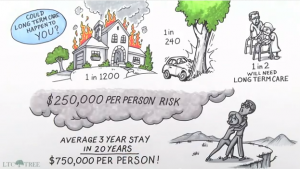Oct 17th, 2012
Long Term Care Insurance policies have been sold since 1974 in some form or another. Coverage for Long Term Care was not ubiquitous, however, until 1996. Until the mid-2000s, many insurance companies could honestly claim that they had never raised their LTC policy rates in history. By 2007, there were few companies left standing with a reputation of no rate increases and many stories have surfaced since 2011 of rate increases as high as 90% on past policyholders.
Evaluating Your Risk of Rate Increases

**1. Work with a broker, not an agent. **If you're just beginning research on Long Term Care coverage, you'll first want to work with an unbiased agent who represents many insurance companies. Too often, agents who represent a single company may place their client with a company with substantial rate increases and less desirable financial ratings because the conversation simply never comes up. As unbiased brokers, we are happy to talk about the companies that have and have not raised prices on their existing clients, and discuss industry trends company by company. That level of candidness is missing from many single-company LTC insurance shops.
**3. Companies selling longer are more likely to have increased. **This seems obvious, but if you've only sold Long Term Care for 10-15 years, you are no where near peak claims, and hence do not need to raise prices at nearly the same rate as companies with 20-year-old books of business. To elaborate, the average purchase age for Long Term Care is in the late 50s, so ten years later a company has a still-healthy group of clients paying premiums and has no need to raise prices, because they're paying virtually no claims yet. Fast forward ten more years, and the average client is late 70s, approaching claim age. Rate will almost certainly be more likely to be increased when a company's book of clients is closer to average claim age. MassMutual and Northwestern (A++ both) have ~15 year old policy books, so their claim to no rate increases should be considered in this context.
Two Pillars of Rate Increase Justification
There are really two major reasons that insurers have had to go back and request rate increases: miscalculations on lapse ratios and, more recently, low interest rates that cannot sustain insurer profitability.
Lapse Ratios: Modeled After Disability
Originally, Long Term Care policies were modeled after disability policies by many insurance actuaries. They suspected that the lapse ratio, or percentage of policyholders that would continue coverage, would be similar. Disability policies are widely known to have an average lapse ratio of 5%, meaning in any given year, 5% of the clients will drop out, having paid premiums but likely never made claims.
Long Term Care clients are planning differently, and as time has passed, the lapse ratio at most companies has trended at approximately 1% instead of 5%. Prescient companies like Genworth Financial noticed this in the early 2000s and begin to adjust their pricing models to reflect a more realistic lapse ratio of 1%. Buck Stinson, VP of LTC at Genworth, stated that lapse ratios had been adjusted by 2005.
Interest Rate Risk
With 30-year mortgages near 3% as of writing, there is very little interest being paid, and very little interest being earned. Insurance companies are like seniors, they depend on interest income to sustain them. One assumption of insurance companies is that they can collect premiums, invest them in low-risk assets, and collect interest at a healthy rate to help cover future claims. With the Fed's insistence on virtually zero real interest rates, and massive amounts of monetary stimulus since the financial collapse of 2008, insurance companies far and wide have been hard hit by diminishing returns on their investments. Long Term Care is especially hard hit because of the spread between the time of purchase and the time of claim (an average of over 20 years!)
As of Fall 2012, one major insurer has privately acknowledged that they are incorporating a 50-year interest rate assumption of 4% into their LTC product pricing.
The Chance of Increases is Decreasing

The ultimate irony of this all is that, as insurance companies more conservatively price their policies and make more realistic assumptions, the chance of future increases actually decreases. As a new policyholder, you'll pay substantially more for the same coverage you could have purchased in past years at much lower rates, but you're also implicitly more insulated from rate increases.
A healthy attitude: build in room for the potential of a rate increase on your shiny new Long Term Care policy, but keep in mind that forces of inflation may help make those future payments easier to make with dollars worth less. Meanwhile, as long as you have inflation protection, your policy is going to be providing more and more value as time goes by.
Contact Us For State-Specifics
Some states are better than others at regulating Long Term Care insurance rate increases. Contact one of our professional agents today for comparison quotes and the full specifics on LTC rate increases in your state.
Get Your Free Comparison of the Top 10+ Insurance Plans
Our educational process will match your needs and budget with the right insurance plan. We will help you compare A+ Long-term care plans, at no charge.
